Chris & Allyson vs. Europe (2017)
Portugal Day Four: Peniche. Braga. Bom Jesus do Monte. Castle of Guimaraes. Porto's fire festival.
The original plan for our fourth day in Portugal was the Berlengas Islands. They're seven miles off the coast, so you take a boat from Peniche to get there. One of the islands has a big fort, and there are birds everywhere. A picture in our Portugal guidebook made it look AWESOME.
Life seldom imitates "The A-Team," so that plan didn't come together. The day before, we got a quick and dirty analysis of the Berlengas from the lady who rented us the BMW: Don't go unless the weather is great. We thought about her advice. If you go to the island, you're stuck there for the day, rain or shine -- and on this day, there were clouds on the horizon. Also, Allyson doesn't care about birds.
So it was decided with very little arguing to do something else. We had breakfast in our motel. We walked on the Peniche beach. We watched people getting ready for surf lessons. We strolled through a few tidal pools. And then we got in the car and drove three hours.
Our destination was influenced by two things: the lady from Hertz -- who clearly had a profound impact on our lives -- and the guidebook. Hertz lady said we should explore the north. It is the "birthplace" of Portugal, rich in history and authentic Portuguese culture. After skimming the "north" section of the guidebook (with a special eye for the coolest illustrations and photos) we opted for a hillside near Braga. We would check out one of the coolest religious sites in the country: Bom Jesus do Monte.
Here's the story: in the 1720s, the archbishop of Braga decided to put an elaborate staircase leading up the hill to an existing shrine to Jesus. Over the next 90 years, that staircase was blinged out to a remarkable extent. Worshippers start at the bottom of the hill and make their way along a wooded trail; that leads to the staircase. At every switchback and landing there's a tiny shrine that shows you, via statuary, a scene from Jesus' own uphill journey: The Passion of the Christ. As you climb the hill, things keep getting worse for Jesus, and he's nailed to some boards by the time you reach the church at the top.
It must have been a moving experience for those on a pilgrimage to Braga. While ascending the mountain, they would experience Christ's ascent to Heaven.
It was less moving for us, because our GPS put us on the road up the hill and dropped us next to the tourist hotel at the top. We skipped right to the big finish. Jesus did not drive a BMW through the pearly gates, so it felt a little less authentic.

Starting at the top! Bom Jesus do Monte.
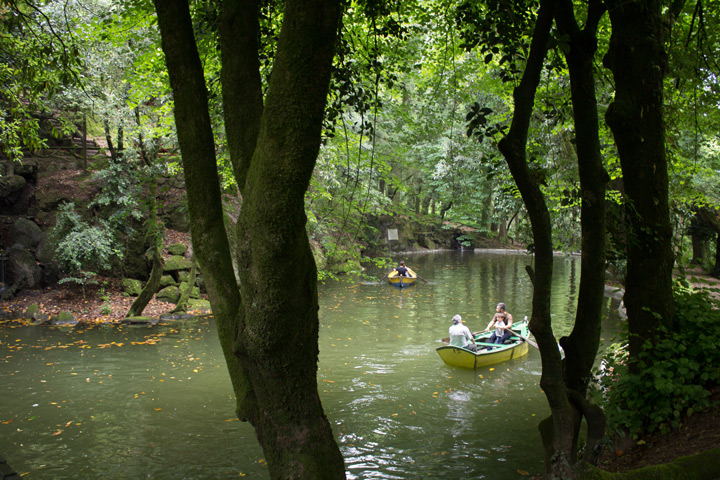
A small boating lake, tucked just uphill from the shrine at Bom Jesus.
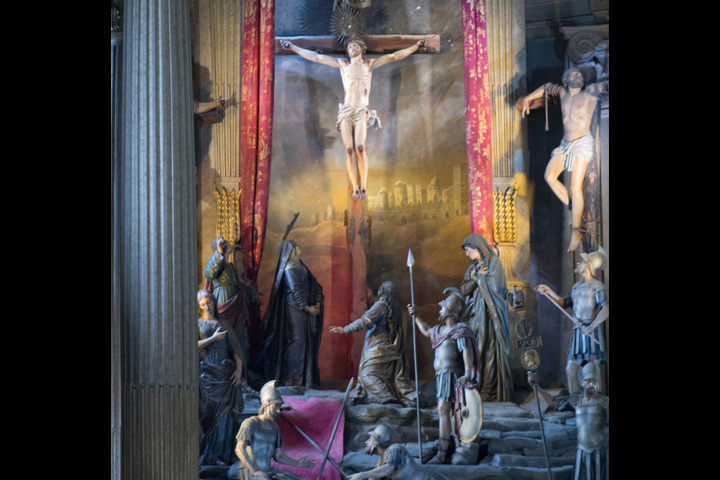
At Bom Jesus the Passion is laid out in 3D, through life-size dioramas.

The view of Braga from the top of the pilgrim's path.
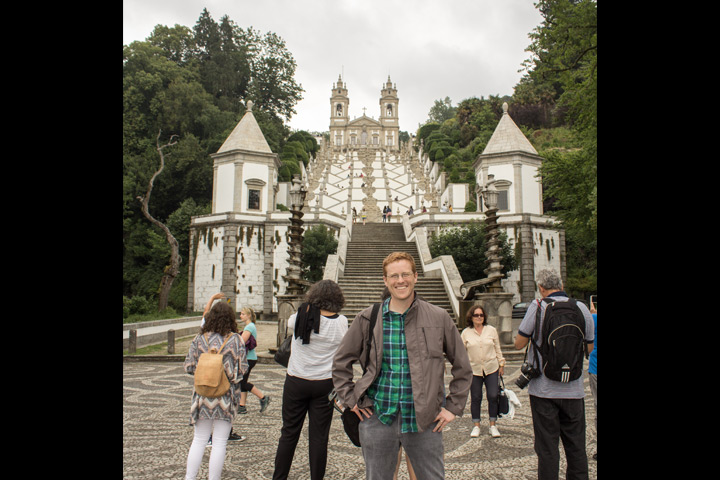
Looking up the cascading staircase -- the proper route to experience Jesus' story.

The entrance to the pilgrim's walk, at the base of Bom Jesus.
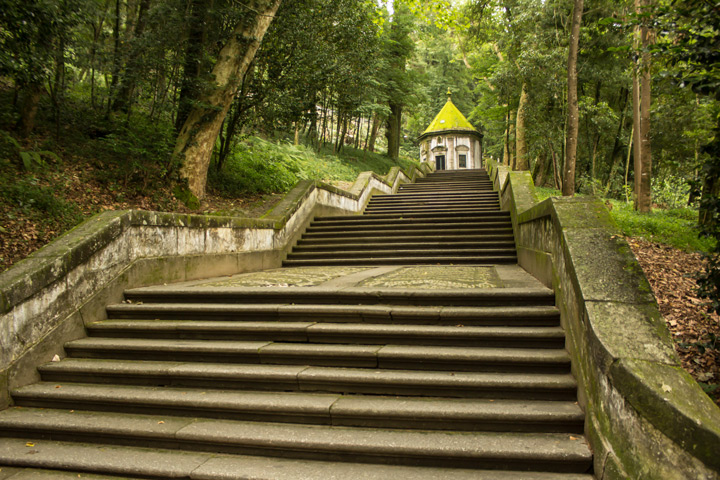
The wooded path near the bottom. The small shrines have statues depicting the Passion.

Taking the cheater's way up: the funicular to the church above.
But it was a great way to see Bom Jesus. After a quick lunch at a hilltop café, we strolled the grounds. Bom Jesus is a shrine AND a tourist trap. The hotel next to the church built an artificial "grotto," and the site might boast the oldest continuously functioning gift shop in Portugal. Some stairs behind the church take you further up the hill, to a small park with a tiny pond where you can rent a rowboat. We didn't, because it seemed silly to row around a body of water smaller than the swimming pool at a Sandals. But it was quaint to see.
We checked out the entrance to the church: A plaza decorated with seven statues of people who betrayed Jesus. We went inside the church, where a mid-day wedding was taking place. Bom Jesus is probably one of those wedding venues you have to book years in advance, with the knowledge that Americans in shorts might be photographing your wedding for their travel blogs.
And then, to get the full experience, we walked DOWN the staircase. We experienced the Passion in reverse. That way, it's a hopeful story about a guy who somehow wriggles off the crucifix, escapes his captors and then has a celebratory dinner with friends. The views of the town are stunning, the shrines are nice enough and there are some interesting statues -- the last three tiers of the staircase, for example, have representations of faith, hope and charity. And there's a crucifix fountain that shoots water out of the nail holes. Fun!
The real fun, however, was explaining the Passion to my Jewish wife. Allyson was aware that Jesus is a thing, but she miraculously avoided learning his story. This makes sense. Christians study the Old Testament, so we have to learn all the plot points for Moses. Jews don't have to study the New Testament, and America does a great job of presenting non-secular versions of the most religious Christian holidays. You can easily coast to adulthood without paying that much attention to Jesus -- and really, if you're not interested in the spiritual part of the story, the Passion is mostly a tame police procedural about the failings of the Roman justice system. So in addition to taking in the many details of Bom Jesus, I got to explain an entire world religion to my wife, or at least the details I remembered from CCD. Any day your wife ASKS to be lectured is a great day.
Ignoring all of Jesus' teachings, when we reached the bottom of the path, we decided to take the cheater's way up. In the 1880s, Portuguese luminaries realized that even when visiting a shrine to Jesus, people will always look for the most slothful way to do it. They built a funicular running parallel to the staircase, powered by the ingenious method of "water counterbalancing": The car at the top has a big tank that gets filled with water, which makes it heavy enough to pull the car on the other track upwards as it descends. Once it's at the bottom, the tank is drained, and the process repeats. We thought we situated ourselves at the front of the car for the three-minute uphill journey, but it turns out you can stand on a platform on the outside of the cabin. So we had a nice view of some Portuguese family's butts.
The town of Braga didn't seem that enticing -- if you've seen one vaguely medieval urban landscape you've seen ‘em all. So we got in the car and proceeded to the next destination on the Hertz lady's list: Guimaraes. (Which, in fairness to Braga, is a vaguely medieval urban landscape.) It is described by some as the birthplace of Portugal, and we went to the maternity ward. Guimaraes' castle is allegedly where Afonso Henriques, the first king of Portugal, was born. It dates back to the 10th century, and it looks like the kind of castle you'd build if invasion by the infidels is a serious concern. It has a big central keep, some high walls, and lots of actual defensive value. Plus convenient nearby street parking!

The birthplace of Portugal? The castle at Guimaraes.

O'er the ramparts we watched. Guimaraes castle.

Inside the Guimaraes keep, getting Medieval on that ass.

Enjoying a Lion's Club concert in the middle of a historic palace.
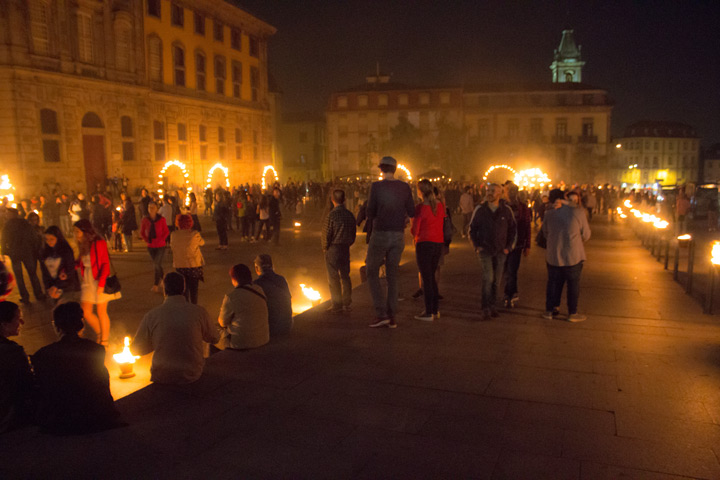
Welcome to Porto, a very .. uh, hot city.
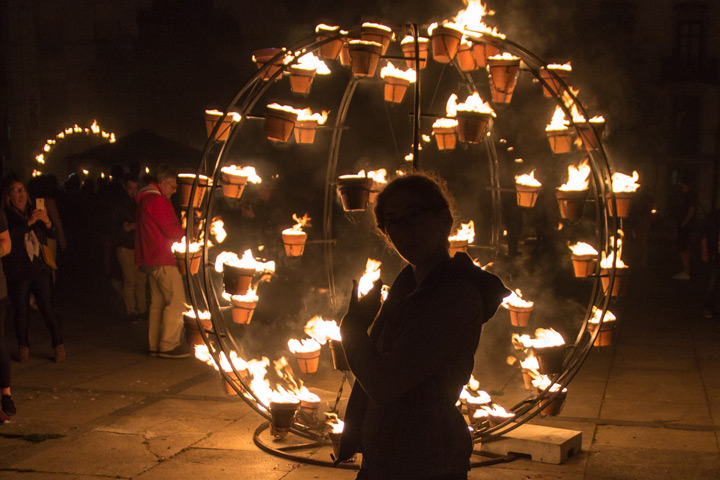
Flame on! A street festival in downtown Porto.

Live music by torchlight. A very cool Porto experience.

She went down in a burning ring of fire. Porto.
Guimaraes was setting up for some kind of urban bike rally that went THROUGH the castle, so we didn't have much time to soak up the Afonso Henriques story. (It probably involves a shooting star, a mysterious crone and the lifting of a 400-year curse. ) Instead, we focused on walking the battlements and cruising quickly through the keep before we were mowed down by authentic, physically fit Portuguese people. And really, that was probably enough. We had already hit our castle quota for this vacation, and asking anything more of Allyson would probably be grounds for divorce.
We strolled the town a little bit, wandering into the nearby Paco dos Duques, a little palace from the 15th century. There we watched part of a Lion's Club concert in its courtyard. Some weird combination of high school kids and adults actually put on a stunning show, with selections from "Porgy and Bess" and a Rossini overture. Naturally, they also had three tenors come out to sing "My Way" in Portuguese. After a little more strolling, we deemed our day in "authentic" Portugal to be a success, and we headed to the next destination: Oporto. AKA Porto.
Porto is the second-biggest city in Portugal. It is a university town, and a cultural hub; many people consider the dining and arts in Porto to be the best in the country. When you are planning your vacation, people will offer you one of two opinions: "Porto is great and I wish we had spent most of our trip there," or "Porto is boring and you can see it in a day."
We were excited to find out what kind of Porto people we were. We found our hotel and somehow crammed our big BMW into the hilariously cramped garage. We checked into our very pleasant room with a nice northern view. And then we struck out in search of food.
Porto is a laid back version of Lisbon. It has plazas, and statues, and churches, and stone streets. It has pedestrian malls, and nightlife, and tourists. It just has less of all those things. It also has fewer vegetarian-friendly restaurants, so we started our "Israelites in the desert" search. At first we were taking in some scenery as we wandered aimlessly, but before long we were very hungry and snippy. No one wanted to make a decision, and our first night in Porto was descending into grumpiness.
That's when we were saved by FIRE. Quite by accident, we stumbled across a very odd cultural program organized by the good people of Porto. In an attempt to draw more people to the city's civic core, they decided to set it ablaze. While walking around looking for restaurants, we saw what looked like a procession of druids carrying torches. You should run either from or with such processions, and since no one else seemed to be screaming in terror, we decided to see where they went. Big civic plazas were taken over by fire-based art: Torches all over the ground, metal frames holding torches in a giant portal / ring, red-hot metal chimneys with artsy cutouts along the side. The "attendants" were all dressed like creepy cult members, and for good measure they had a two-person band playing some very creepy gothic-synth stuff. It was like the Undertaker's ring entrance, transformed into a public art event.
The plaza was jammed with onlookers, enjoying the flames and taking a ton of selfies. We were right there with them, because it WAS that cool. The fire made us forget our hunger for a little while, and when we were finally ready to move on we quickly settled on "Café de Paris." It seemed like the Portuguese version of a Tchotchkes, with a bunch of crap (including a car) hanging on the walls. But the food was good enough, they had something vegetarian on the menu, and we were able to get in and out without too much trouble.
And did I mention the fire? There was fire! It was a strange but memorable introduction to the city. So always remember this travel tip: When you see guys dressed like undertakers carrying torches, follow them.
